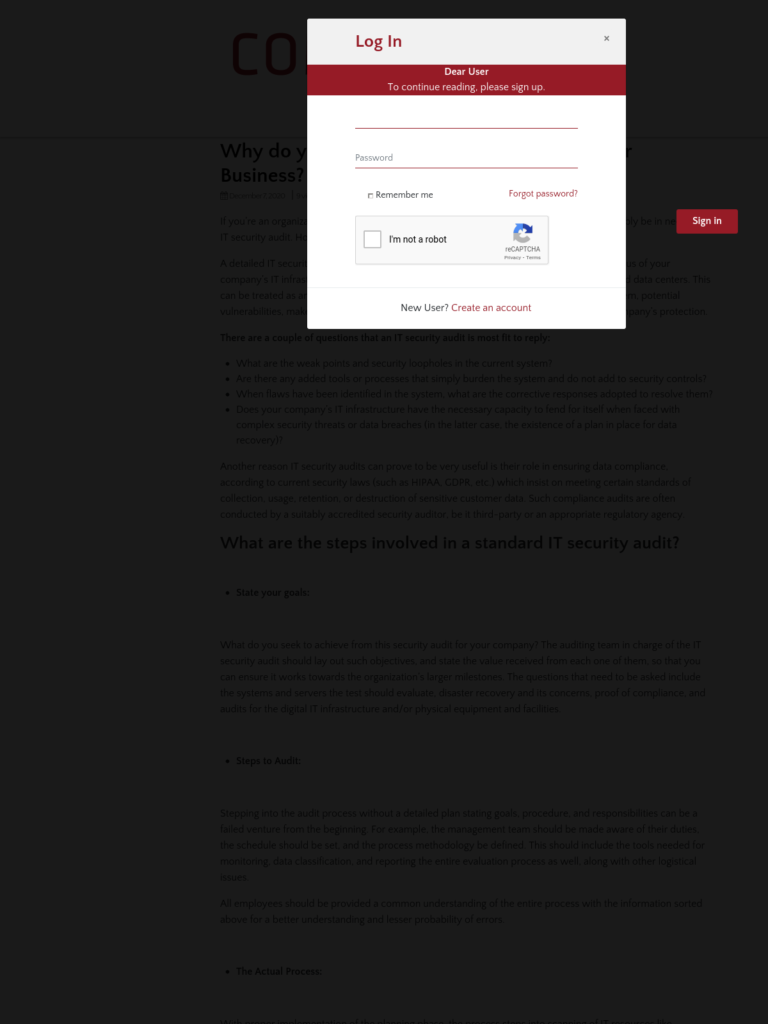Why do you need an IT Security Audit for your Business?
Blog: NASSCOM Official Blog
If you’re an organization looking to achieve its security and compliance goals, you will probably be in need of an IT security audit. However, why do you need a security audit?
A detailed IT security audit provides you the opportunity to study and verify the security status of your company’s IT infrastructure, including the hardware, software, network security strength, and data centers. This can be treated as an assessment report of the entire organization’s information security system, potential vulnerabilities, make sure of regulatory compliance, and strengthen security controls for company’s protection.
There are a couple of questions that an IT security audit is most fit to reply:
- What are the weak points and security loopholes in the current system?
- Are there any added tools or processes that simply burden the system and do not add to security controls?
- When flaws have been identified in the system, what are the corrective responses adopted to resolve them?
- Does your company’s IT infrastructure have the necessary capacity to fend for itself when faced with complex security threats or data breaches (in the latter case, the existence of a plan in place for data recovery)?
Another reason IT security audits can prove to be very useful is their role in ensuring data compliance, according to current security laws (such as HIPAA, GDPR, etc.) which insist on meeting certain standards of collection, usage, retention, or destruction of sensitive customer data. Such compliance audits are often conducted by a suitably accredited security auditor, be it third-party or an appropriate regulatory agency.
What are the steps involved in a standard IT security audit?
- State your goals:
What do you seek to achieve from this security audit for your company? The auditing team in charge of the IT security audit should lay out such objectives, and state the value received from each one of them, so that you can ensure it works towards the organization’s larger milestones. The questions that need to be asked include the systems and servers the test should evaluate, disaster recovery and its concerns, proof of compliance, and audits for the digital IT infrastructure and/or physical equipment and facilities.
- Steps to Audit:
Stepping into the audit process without a detailed plan stating goals, procedure, and responsibilities can be a failed venture from the beginning. For example, the management team should be made aware of their duties, the schedule should be set, and the process methodology be defined. This should include the tools needed for monitoring, data classification, and reporting the entire evaluation process as well, along with other logistical issues.
All employees should be provided a common understanding of the entire process with the information sorted above for a better understanding and lesser probability of errors.
- The Actual Process:
With proper implementation of the planning phase, the process steps into scanning of IT resources like database servers, file-sharing services, and SaaS applications like Office365 that will help understanding aspects like network security, user access rights, data access, and other system configurations.
Devote some time towards physically inspecting the data center for resilience against security issues, power surges, and other disaster recovery plans. Address all holes in the organization’s security procedures
- Finalize the results and take appropriate action:
Prepare a formal report with all the details received from the audit process that can then be forwarded to the stakeholders of the company and the agency. The report should include a list of all the security risks and loopholes detected during the analysis and recommended actions for their mitigation.
Couple of recommended actions include fixing flaws or weak spots, providing employees training on best security practices and training, appropriate handling of sensitive data, recognizing symptoms of phishing attacks, and new technologies for hardening existing security levels.
Even after the audit, there should be regular monitoring to detect any sudden and suspicious changes or other risks. When following through the recommended actions, steps to enhance existing security levels should also be kept in mind.
Things to keep in mind for a successful security audit
Make sure that all goals to be achieved through the security audit process are clearly identified and communicated to all stakeholders, including the auditing team, the management team, and the organization. The general objective is to identify flaws and weaknesses within the IT infrastructure, so a precise definition of what needs to be targeted and achieved maintains focus of the audit process.
This is often taken as given, but ensure that adequate permissions and support have been gained from key positions within the organization, such as the chief information officer. This also gives you clear access to any important resources. Finally, the most important lesson is to plan out a periodic schedule for conducting such comprehensive IT security audits frequently, ensuring adequate data compliance and critical recognition of security vulnerabilities as the organization grows.
The post Why do you need an IT Security Audit for your Business? appeared first on NASSCOM Community |The Official Community of Indian IT Industry.
Leave a Comment
You must be logged in to post a comment.








